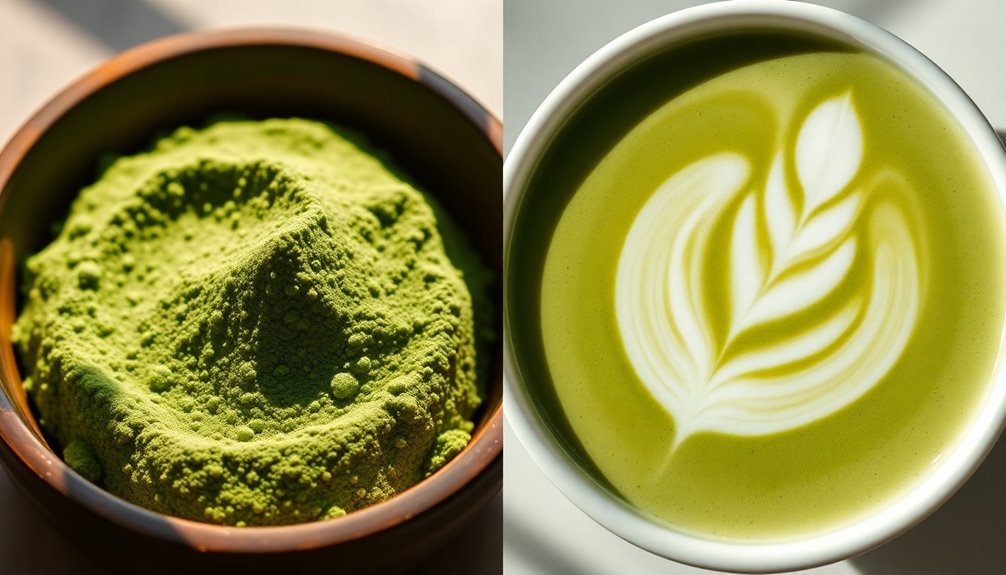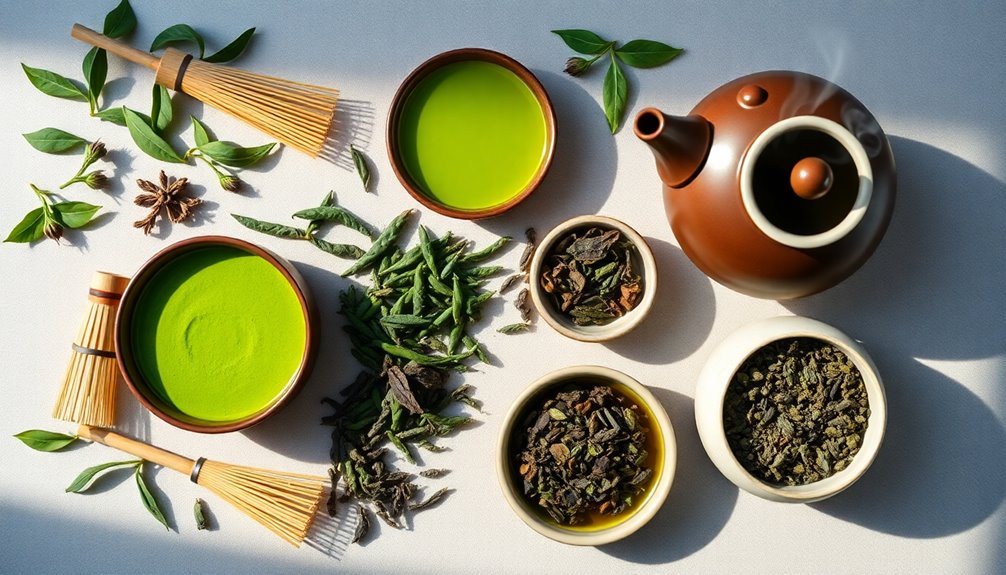To grow oolong tea, start by selecting a subtropical climate where temperatures range between 60°F and 85°F. Choose well-drained, slightly acidic soil with a pH of 5. 5 to 6. 5. Soak your seeds for 24-48 hours before planting them in early spring, spacing them 3-4 feet apart for air circulation. Make certain they get 4-6 hours of direct sunlight each day, and keep the soil moderately moist without waterlogging. Regularly check for pests and use organic fertilizers for healthy growth. With the right care, you can enjoy a rewarding harvest of delicious oolong leaves in just a few years. There’s much more to explore! In addition to growing your own oolong tea, it’s essential to learn how to brew oolong tea properly to fully appreciate its unique flavors. Once you’ve harvested the leaves, use fresh, filtered water and heat it to around 190°F to 200°F before steeping the leaves for 3-5 minutes. Experiment with different steeping times and quantities to discover the perfect brew that suits your palate. Enjoy the journey from garden to cup!
Key Takeaways
- Plant oolong tea seeds in early spring in well-drained, slightly acidic soil with a pH between 5.5 and 6.5.
- Ensure the plants receive 4-6 hours of direct sunlight daily for optimal growth.
- Keep the soil moderately moist, avoiding waterlogging to prevent root rot.
- Monitor for pests like aphids and spider mites, using organic control methods as needed.
- Harvest young leaves after three years, processing them immediately for best flavor.
Understanding Oolong Tea

Oolong tea, a delightful middle ground between green and black tea, offers a unique flavor experience that's hard to resist.
This partially oxidized tea comes from the younger leaves and buds of the Camellia sinensis plant. The oxidation process varies between 10% and 80%, resulting in a diverse flavor profile ranging from floral to toasty notes.
During the processing of oolong tea, leaves are withered under sunlight and bruised to kickstart oxidation, followed by careful drying to stop the process at the desired level.
Not only does oolong tea taste fantastic, but it also boasts incredible health benefits, including aiding weight loss, improving heart health, and providing a rich source of antioxidants that combat oxidative stress.
Enjoy discovering this unique flavor!
Ideal Growing Conditions

To grow healthy oolong tea, you need to pay attention to its ideal growing conditions.
These plants thrive in subtropical climates with temperatures between 60°F and 85°F, prefer well-drained, slightly acidic soil, and require plenty of sunlight.
Temperature Requirements
When growing oolong tea, maintaining the right temperature is essential for ideal growth and flavor development. Aim for consistent temperatures between 70°F to 85°F (21°C to 29°C) for peak growth.
Here are key points to remember:
- Keep temperatures above 60°F (15°C) to avoid stunted growth and poor leaf quality.
- Work towards an average temperature of around 75°F (24°C) during the growing season for healthy leaf development.
- Nighttime temperatures shouldn't drop too low; drastic fluctuations can stress your plants.
- In cold weather, use protective measures like mulching or indoor cultivation to guarantee survival.
Soil Preferences
For ideal growth, oolong tea plants prefer well-drained, sandy loam soil that maintains a slightly acidic pH between 5.5 and 6.5.
This type of acidic soil is vital for healthy root development and overall vigor. To enhance your soil, enrich it with organic matter like compost or sphagnum moss, which boosts nutrient levels and improves moisture retention while ensuring adequate drainage.
Remember, oolong tea plants don't tolerate waterlogged conditions; poor drainage can lead to root rot.
Regular soil testing is important for monitoring pH and nutrient levels, allowing you to make timely amendments.
Sunlight Exposure
While oolong tea plants can tolerate some shade, they truly flourish in full sunlight, needing at least 4-6 hours of direct sun each day. This consistent exposure is crucial for healthy growth and ideal leaf production.
Ideally, you should position your oolong tea to benefit from morning sunlight and afternoon shade to protect the leaves from scorching heat.
Here are some tips for sunlight exposure:
- Confirm at least 4-6 hours of direct sunlight daily.
- Favor morning sunlight for gentle warmth.
- Provide afternoon shade to prevent leaf burn.
- Monitor plant health regularly to adjust light conditions.
Proper sunlight not only enhances flavor but also boosts the overall quality and yield of your oolong tea harvest.
Planting Oolong Tea Seeds

Planting oolong tea seeds is an exciting step towards cultivating your own flavorful brew. First, soak the seeds in water for 24-48 hours to kickstart germination. Choose a well-drained, sandy soil with a pH between 5.5 and 6.5 for ideal growth. Plant the seeds in early spring after the last frost, making sure temperatures are between 70°F and 85°F.
Here's a quick overview:
| Step | Details | Tips |
|---|---|---|
| Soaking | 24-48 hours | Initiates germination |
| Soil Requirements | Sandy, acidic (pH 5.5-6.5) | Guarantees healthy growth |
| Spacing | 3-4 feet apart | Aids air circulation |
Maintain consistent moisture but avoid overwatering to prevent root rot. Happy planting!
Daily Care Requirements

Once you've successfully planted your oolong tea seeds, daily care becomes essential to nurture their growth. Here's what you need to focus on:
- Watering: Keep the soil moderately moist, avoiding waterlogging to prevent root rot.
- Sunlight: Monitor exposure; oolong thrives in partial shade to avoid leaf burn while still getting adequate light.
- Fertilization: Use organic fertilizers during the growing season to boost healthy leaf production.
- Pruning: Regularly prune to promote healthy branching and airflow, reducing disease risk.
Don't forget to check for pests like aphids or spider mites.
Routine inspections and organic pest control methods will help protect your oolong without harming its growth. Consistent care guarantees your plants flourish beautifully!
Harvesting Oolong Tea Leaves

Harvesting oolong tea leaves is a crucial step in the tea-making process that can greatly impact flavor and quality. You should aim to harvest when the leaves are young and tender, ideally in the morning after the dew has evaporated. Begin harvesting around three years after planting, as this allows the plants to produce quality leaves. Use sharp scissors to carefully pick the leaves, ensuring minimal damage to the plant. During the growing season, harvest every 1-2 weeks to encourage new growth. After you harvest, process the leaves immediately to preserve their freshness, as oolong tea requires specific oxidation techniques.
| Harvesting Tips | Timing | Tools |
|---|---|---|
| Young and tender leaves | Morning after dew | Sharp scissors |
| Every 1-2 weeks | 3 years after planting | Garden shears |
| Process immediately | During growing season | Pruning shears |
Processing Oolong Tea

After you've successfully harvested your oolong tea leaves, the next step is processing them to develop the unique flavors that oolong tea is known for.
Here's how you can do it:
- Wither the tea leaves under sunlight for 45 minutes to kickstart the oxidation process.
- Let the leaves rest at room temperature for several hours, stirring hourly for even oxidation.
- Look for the edges of the leaves turning red—this means they're ready for the next step.
- Dry the leaves in an oven at 250°F for about 20 minutes to halt oxidation.
Finally, store your processed tea in an airtight storage container to maintain freshness and enjoy this healthy beverage from your tea bushes!
Brewing Techniques for Oolong

To brew the perfect cup of oolong tea, you'll want to start with water heated between 190°F and 200°F.
Steeping for 3 to 5 minutes will allow you to control the strength based on your taste preferences.
Ideal Water Temperature
When brewing oolong tea, achieving the right water temperature is essential for releasing its intricate flavors. The ideal range is between 190°F to 200°F (88°C to 93°C). This temperature reveals the depth of the leaves, allowing you to enjoy the tea's rich aroma and taste.
To enhance your brewing experience, remember these tips:
- Use 1 teaspoon of loose oolong leaves per 8 ounces of water.
- Start with a longer steep time for the first infusion.
- Gradually reduce steep time for subsequent brews.
- Enjoy multiple infusions, as the same leaves can yield up to 5 flavorful cups.
With these techniques, you'll guarantee your oolong tea grows in flavor and richness, fulfilling your tea-loving heart.
Steeping Time Guidelines
While you might be tempted to steep oolong tea for just a minute or two, achieving the best flavor requires a bit more patience.
To extract ideal flavor without bitterness, steep your loose tea leaves at a water temperature of 190°F to 200°F. The recommended steeping time for oolong tea is typically between 3 to 5 minutes, depending on the strength you prefer and the specific variety.
If you plan to enjoy multiple infusions, increase the steeping time by about 30 seconds to 1 minute for each subsequent brew.
Using about 1 teaspoon of loose tea leaves per cup will help you achieve a balanced flavor profile, allowing each infusion to reveal unique characteristics and notes.
Common Pests and Solutions

Oolong tea plants can face several common pests that threaten their growth and health.
To guarantee your plants thrive, be vigilant about these issues:
- Aphids: Introduce natural predators like ladybugs or use insecticidal soap.
- Spider mites: Maintain proper humidity and regular watering to prevent infestations.
- Whiteflies: Employ yellow sticky traps and neem oil sprays for effective control.
- Pests: Regularly inspect your plants and maintain healthy soil to reduce risks.
Benefits of Growing Oolong Tea

Successfully managing pests is just one part of the rewarding journey of growing oolong tea. This semi-oxidized tea not only tantalizes your taste buds but also offers significant health benefits.
Oolong tea is rich in antioxidants, helping combat free radicals and potentially aiding in weight management and improving heart health. As you cultivate these plants, you'll enhance local biodiversity, attracting pollinators and beneficial insects that thrive in your garden.
With oolong tea plants capable of living over 100 years, you're investing in long-term sustainability. Plus, immersing yourself in this gardening experience allows you to connect with nature, fostering mindfulness and boosting your mental well-being.
Embrace the journey and enjoy the myriad benefits of growing oolong tea!
Frequently Asked Questions
Can I Grow My Own Oolong Tea?
Yes, you can definitely grow your own oolong tea!
You'll need to start with Camellia sinensis plants, so make certain you have well-drained, sandy soil with a slightly acidic pH.
Keep your plants in temperatures between 70°F to 85°F and guarantee they get at least 4-6 hours of sunlight daily.
Regular pruning helps promote bushy growth, and remember to harvest those young leaves in the morning for the best flavor!
How Is Oolong Tea Grown?
Growing oolong tea's like nurturing a delicate dance; you need the right steps.
Start by choosing a warm, humid spot with well-drained, slightly acidic soil. Plant your young Camellia sinensis leaves, spaced 3-4 feet apart for good air circulation.
Make sure they soak up 4-6 hours of sunlight daily. Harvest the tender leaves every 1-2 weeks, ideally in the morning, to capture the best flavor and aroma for your tea.
Can You Grow Tea Trees in the USA?
Yes, you can grow tea trees in the USA, particularly in subtropical and tropical areas like California and the southern states.
You'll need to guarantee your tea plants, specifically Camellia sinensis, have well-drained, acidic soil with a pH of 5.5 to 6.5.
They thrive in temperatures between 60°F and 85°F, requiring at least 4-6 hours of sunlight daily.
With proper care, including watering and frost protection, you can cultivate healthy tea trees.
What Plant Produces Oolong Tea?
Oolong tea's deliciously distinctive flavor comes from the Camellia sinensis plant.
This remarkable shrub's leaves not only produce oolong but also black and green teas.
If you're seeking quality, focus on the Camellia sinensis var. sinensis, known for its smaller leaves and milder taste.
When you sip oolong, you're savoring a delightful dance of flavors, thanks to its unique partial oxidation, bridging the gap between green and black teas seamlessly.
Conclusion
Growing oolong tea is a rewarding journey. You'll nurture the plants, enjoy the process, and savor the results. By providing the right conditions, caring for your tea, and mastering the art of brewing, you'll create a personal connection to each cup. Whether you're sipping on a fresh brew or sharing it with friends, you're not just cultivating tea; you're cultivating memories, fostering relaxation, and embracing a tradition that spans generations. Enjoy every moment of it!










